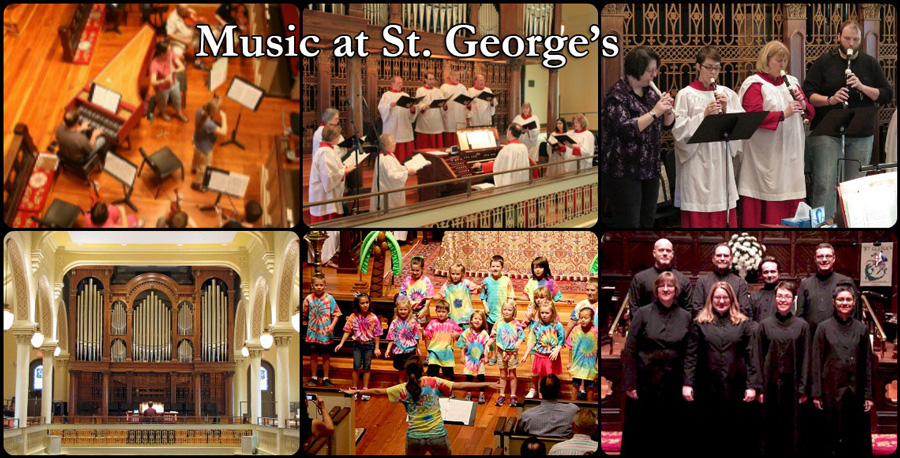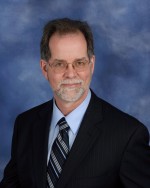
The music program had been under Susan Onderdonk for most of the 1990’s . Susan’s forte was the choir of all ages, including children.
She left in August, 1999 and the music program embarked upon rapid changes. In July, 2002, Dr. Patricia Parker was hired . The Search committee wrote “Patricia Parker has been selected as our new Director of Music. It is very exciting to bring someone on board who is very talented with children and with our pipe organ”
The solitary music director idea was on the wane. In September, 2003, then assistant Nathan Ferrell wrote about future staffing needs. “He said we would need a full-time youth minister, an education director, and an Outreach Director, as well as dividing the organist position from that of the Music Director.” Parker resigned in April, 2004. Her potential was not realized at St. George
Brad Volland had been contracted for as the interim organist and Paige Martindale as the Interim Music Director as self-employed individuals. Work Agreements were signed on April 21. Hiring a full-time Minister of Music or perhaps two individuals to divide that role would wait until after the new Rector was in place. Charles Sydnor had left St. George’s in 2003 due to his wife’s medical condition and so the church faced an interim period with an interim rector and interim music program.
In June, 2004, Rector Search Committee reflection group reports and other sources and had discerned that the congregation wanted all of the music components it has had in the past (three choirs, two bell choirs) plus more participation from the congregation, both in voices and in instruments. They saw perhaps the need for a team of part-time folks to handle the Music (organist, overall Minister of Music, bell choir director, etc.).
Volland and Martindale left at the end of 2004 as new rector James Dannals began his ministry at St. George’s

John Vreeland was hired in July, 2005 beating out 80 candidates
In May, 2013, John Vreeland described the changes in the music department as follows. He had been at St George’s not quite 8 years.
St. George’s music program in July 2005:
- One Eucharist with music
- One volunteer adult choir of 12-18 that sang weekly
- A volunteer-led hand bell choir of 10-12 that rang occasionally.
- Ecumenical children’s summer arts camp, with limited participation by St. George’s children
- An organ composed of a large collection of pipes and components from several different instruments, including Erben, Moller and Organ Supply Company, last updated in the 1980’s, which lacked a cohesive sound and was difficult to maintain and tune
St. George’s music program in May of 2013:
- Three Eucharists with music
- Three adult choirs, two of whom perform weekly, with 36 members total
- Two children’s choirs who currently perform monthly with 15 members total
- A volunteer-led hand bell choir of 10-12 who perform weekly, alternating between the 9 and 11 AM Eucharists
- A 13 member jazz ensemble that supports the 9 AM Eucharist composed of flute, two alto saxes, one doubling on clarinet, tenor sax, baritone sax, two trumpets, trombone, piano, guitar, bass, drums and a second percussionist who plays vibes, congas and timbales
- A chamber ensemble that supports the 11 AM Eucharist composed of two violins, cello, flute, oboe doubling on English horn, clarinet, French horn and bassoon
- Two Celtic ensembles that support the 5:30 PM Celtic Eucharist, composed of guitar, piano, and flute or violin
- Sung Compline at 9 PM on Sunday evenings
- A new three manual and pedal Parsons tracker organ that provides excellent support for worship and has received rave reviews from concert organists, the congregation and the community of Fredericksburg.
- A monthly concert series, now in its fourth season, that provides musical outreach to the Fredericksburg region by providing high quality performances at a reasonable cost and provides a community showcase for St. George’s musicians
- The St. George Chamber Orchestra, who perform three concerts per year in the above series
There are three additional music staff:
- A part-time salaried Children’s Choir Director and Music Librarian (10 hours/week)
- A part-time salaried Assistant Organist/Pianist (5 hours/week)
- A full-time volunteer Music Administrator/Hand bell director (40+ hours/week)
It should be noted that:
- It currently requires 120 hours/week by four trained music staff to keep St. George’s Music Program running.
- Every hour of rehearsal or church service requires up to two hours of preparation time for administrative tasks, music arranging, organ/piano practice, score study, long range and rehearsal planning
- Nearly all tasks involved in leading the music program require advanced musical training and/or experience in music theory, vocal and instrumental technique, performance, conducting, composition, and arranging
Due to the demands on John , the part time organist was moved to 20 hours
The musical, professional and spiritual growth in St. George’s music program over the past seven years has been nothing short of amazing. While our program growth is certainly something to celebrate, it does create an unmanageable workload for the Director of Music Ministries.
Music also changed in relationship to others. The Worship and Music Commission has evolved from 2011-2012. It is now a commission comprised of the chairs/leads of various ministries associated with worship. Previously, the commission had members who only interested in the broader commission or aspects of the ministries. It represented acolytes, altar guild, flower guild, lay readers, LEV, Liturgical coordinators, the ushers as well as music
By 2014, they had begun additional summer events – YogaVoice Workshop in 2014-2015, Children’s Music Theater Camp yearly since 2014 and an annual Music Retreat in August
In January, 2015 the jazz ensemble entertained the Diocesan annual council. They also expanded to perform at 1st Night performances. By that time, St. George’s was able to attract other organists – Trystan Bennett and Achim Loch who provided depth to the program.
